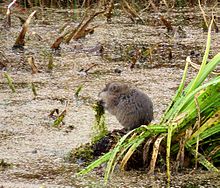Nordic vole
| Nordic vole | ||||||||||||
|---|---|---|---|---|---|---|---|---|---|---|---|---|

Nordic vole |
||||||||||||
| Systematics | ||||||||||||
|
||||||||||||
| Scientific name | ||||||||||||
| Microtus oeconomus | ||||||||||||
| ( Pallas , 1776) |
The Nordic vole or swamp mouse ( Microtus oeconomus ) is a mammal from the subfamily of the voles (Arvicolinae). The species colonizes moist habitats in large parts of the Holarctic , the western limit of distribution in Europe runs through Germany roughly along the Elbe .
features
The head-trunk length is 95–135 mm, the tail length 39–64 mm, the length of the hind foot 17.3–21.0 mm and the ear length 11–14 mm. The animals weigh 20-64 g. The fur is yellowish gray on top, the middle of the back is darker black-brown. The underside is whitish.
distribution and habitat
The distribution area of the Nordic vole covers large parts of the northern Holarctic . In Eurasia, the more or less closed area extends in a west-east direction from eastern Central Europe and northern Norway to Kamchatka and the Kuril Islands . The western limit of distribution runs through Germany roughly along the Elbe . In north-south direction, the European area stretches from northern Norway to southern Poland . To the west and south of the closed area there are geographically isolated relic occurrences on the Finnish Baltic Sea coast, in southern Norway and neighboring central Sweden , in the Netherlands and in the border triangle of eastern Austria, southwest Hungary and Slovakia . The species also lives in north-western North America from the west coast of Alaska to the central north of Canada .
The Nordic vole shows a close connection to moist habitats with high and dense vegetation. They settled wet meadows, reed beds, moors, alder forests and stream and river banks, as well as kettle holes and edges grave on farmland. For wintering, drier areas within the populated habitats, but also neighboring drier meadows or even houses are sought out.
Way of life
Nordic voles swim very well. The sometimes multi-storey corridor system is laid out in peat and moss cushions, partly also above ground in dense herbaceous vegetation. There are fixed droppings and feeding places within this passage system. The food, which is probably exclusively plant-based, consists of grass, sedges , herbs, young reed plants and horsetail , and in winter the outer layer is often eaten by rushes .
The reproduction takes place from the middle of March or the beginning of April to the end of September, exceptionally also until November. The gestation period is 20 to 23 days. The litters include 3–9, mostly 5–7 young. The newly born young mice weigh 1.9-3.1 g. The eyes open at 10 days of age; the suckling period is about three weeks. As with other members of the Microtus genus, females are sexually mature as early as a few weeks old.
Existence, endangerment and protection
According to the IUCN, the world population is considered to be safe ("least concern"). However, the area is shrinking at the southwestern boundary in Poland and in Germany the species is listed as "endangered" in the Red List (Category 3) due to its close ties to extensively used, open habitats and the threat to these habitats due to increased use . The geographically isolated occurrences in the Netherlands, in the border triangle of Austria, Hungary and Slovakia as well as a number of subspecies endemic to islands in North America are also considered endangered .
The subspecies Microtus oeconomus arenicola and Microtus oeconomus mehelyi are listed as priority species in Annexes II and IV of the Habitats Directive and are therefore considered to be strictly protected species of Community interest in the European Union , for which special protected areas must be designated.
swell
Individual evidence
literature
- Anthony J. Mitchell-Jones, Giovanni Amori, Wieslaw Bogdanowicz, Boris Krystufek, PJH Reijnders, Friederike Spitzenberger, Michael Stubbe, Johan BM Thissen, Vladimiŕ Vohralik, Jan Zima: The Atlas of European Mammals. Poyser, London, 1999, ISBN 0-85661-130-1 , pp. 244-245.
- Erwin Stresemann (founder), Konrad Senglaub (ed.): Excursion fauna of Germany. Volume 3: Vertebrates. 12th, heavily edited edition. G. Fischer, Jena et al. 1995, ISBN 3-334-60951-0 , p. 424.
Web links
- Microtus oeconomus in the endangered Red List species the IUCN 2009. Posted by: Linzey, AV, Shar, S., Lkhagvasuren, D., Juskaitis, R., Sheftel, B., Meinig, H., Amori, G. & Henttonen , H., 2008. Retrieved November 18, 2009.
